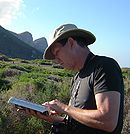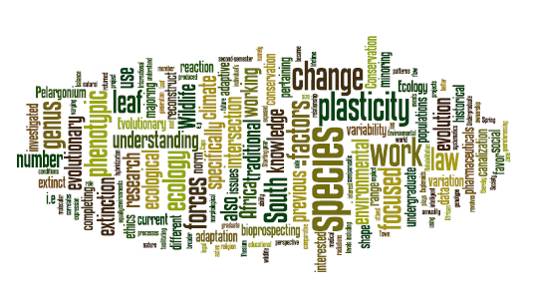Difference between revisions of "Schlichting Lab Research Crew"
(→Graduate Students) |
|||
| (11 intermediate revisions by the same user not shown) | |||
| Line 1: | Line 1: | ||
| − | + | == == | |
| + | |||
=='''Dr. Carl Schlichting'''== | =='''Dr. Carl Schlichting'''== | ||
| − | [[Image:Carlthumb.jpg| | + | [[Image:Carlthumb.jpg|130px|left]] |
My research revolves around understanding the forces that shape the evolution of the phenotype, from the perspective of the reaction norm (i.e., the range of phenotypes that will be produced by a genotype when it is exposed to different environments). Experimentally I have studied the morphological responses of species and populations to environmental variability (their phenotypic plasticity), but I have become equally interested in the other side of the coin, namely what evolutionary forces operate to restrict the expression of phenotypic variation (the lack of plasticity, i.e., canalization). Some selective factors will favor plasticity, other forces favor canalization. The reaction norm that we observe has been forged by the balance of forces in this tension zone. There are a number of factors that impinge on the outcome: the predictability of environmental change, the ability to sense the change (or its correlates), the spatial or temporal nature of variability, and the scale at which it is perceived (e.g., within an individual's lifetime). We are currently working with the genus ''Pelargonium'' in South Africa to understand these issues better. | My research revolves around understanding the forces that shape the evolution of the phenotype, from the perspective of the reaction norm (i.e., the range of phenotypes that will be produced by a genotype when it is exposed to different environments). Experimentally I have studied the morphological responses of species and populations to environmental variability (their phenotypic plasticity), but I have become equally interested in the other side of the coin, namely what evolutionary forces operate to restrict the expression of phenotypic variation (the lack of plasticity, i.e., canalization). Some selective factors will favor plasticity, other forces favor canalization. The reaction norm that we observe has been forged by the balance of forces in this tension zone. There are a number of factors that impinge on the outcome: the predictability of environmental change, the ability to sense the change (or its correlates), the spatial or temporal nature of variability, and the scale at which it is perceived (e.g., within an individual's lifetime). We are currently working with the genus ''Pelargonium'' in South Africa to understand these issues better. | ||
| + | |||
| + | |||
| + | |||
==Graduate Students== | ==Graduate Students== | ||
==='''Colin J. Carlson'''=== | ==='''Colin J. Carlson'''=== | ||
| − | [[Image:Carlsonthumb.jpg| | + | [[Image:Carlsonthumb.jpg|130px|left]] |
Colin is a second-semester Master's student. After completing his undergraduate work with a B.S. in EEB and a B.A. in Environmental Studies from UConn in 2012, Colin returned to the lab to work on a number of different projects pertaining to adaptation of ecosystems and societies to climate change. His previous work has focused on understanding the ecological implications of phenotypic plasticity for adaptation to climate change in the South African genus ''Pelargonium''. His research has also focused on a number of broader social issues, including the relationship between religion and conservation (in the intersection formed by sacred forests); the protection and legal ownership of traditional ecological knowledge; and resilience of social and ecological systems to climate change as a function of cultural stability. His current work focuses on identifying the factors that drive species to extinction, using historical data to reconstruct actual extinction events, and thereby identify the factors that caused them. | Colin is a second-semester Master's student. After completing his undergraduate work with a B.S. in EEB and a B.A. in Environmental Studies from UConn in 2012, Colin returned to the lab to work on a number of different projects pertaining to adaptation of ecosystems and societies to climate change. His previous work has focused on understanding the ecological implications of phenotypic plasticity for adaptation to climate change in the South African genus ''Pelargonium''. His research has also focused on a number of broader social issues, including the relationship between religion and conservation (in the intersection formed by sacred forests); the protection and legal ownership of traditional ecological knowledge; and resilience of social and ecological systems to climate change as a function of cultural stability. His current work focuses on identifying the factors that drive species to extinction, using historical data to reconstruct actual extinction events, and thereby identify the factors that caused them. | ||
| + | |||
| + | |||
| + | |||
| + | |||
| + | |||
| + | ==='''Timothy Moore'''=== | ||
| + | [[Image:tim.jpg|130px|left]] | ||
| + | |||
| + | Timothy is a second year PhD student, who moved to the University of Connecticut after completing his Undergraduate and Master of Science degrees at the University of Cape Town, South Africa. He has an interest in plant evolutionary biology, specifically, molecular systematics, comparative biology, and evolutionary ecology. His previous work has investigated the evolution and ecology of the semiparasitic genus, Thesium in South Africa. He has also investigated the evolution of annuality in the grass Ehrharta caylicina, and the adaptive significance of leaf size and shape variation in the genus Jamesbrittenia. His current focus lies in understanding the role that hybridization plays in species’ geographic range expansion, and, ultimately in facilitating adaptive radiations. He hopes to use spatially explicit species distribution data, and next generation sequencing techniques to elucidate patterns of gene flow between populations and between species. | ||
| + | |||
| + | |||
| Line 23: | Line 38: | ||
==='''Katherine Shaw'''=== | ==='''Katherine Shaw'''=== | ||
''' ''Bio needed.'' ''' | ''' ''Bio needed.'' ''' | ||
| − | + | ||
| − | + | ||
| − | + | ||
| − | + | ||
| − | + | ||
| − | + | ||
| − | + | ||
| − | + | ||
==Undergraduates== | ==Undergraduates== | ||
| Line 51: | Line 59: | ||
Michael is a recent graduate of the University of Connecticut majoring Biology and minoring in Ecology and Evolutionary Biology. Some of Michael’s previous research focused on the phenotypic plasticity of Euglenoids and their response to varying environmental conditions, specifically photic levels. His future plans for his educational career are to attend law school, specifically interested in intellectual property and patent law related to pharmaceuticals and medical products. Michael is also passionate about conservation and the intersection of ecology with law, pertaining to the preservation of and intelligent use of our natural world. Michael will be working on a project focused on the intersection of law, ethics and ecology in the context of bioprospecting and the use of traditional knowledge in the pharmaceutical industry. | Michael is a recent graduate of the University of Connecticut majoring Biology and minoring in Ecology and Evolutionary Biology. Some of Michael’s previous research focused on the phenotypic plasticity of Euglenoids and their response to varying environmental conditions, specifically photic levels. His future plans for his educational career are to attend law school, specifically interested in intellectual property and patent law related to pharmaceuticals and medical products. Michael is also passionate about conservation and the intersection of ecology with law, pertaining to the preservation of and intelligent use of our natural world. Michael will be working on a project focused on the intersection of law, ethics and ecology in the context of bioprospecting and the use of traditional knowledge in the pharmaceutical industry. | ||
| + | |||
| + | |||
| + | |||
| + | |||
| + | ==Lab Publication List== | ||
| + | |||
| + | ===2000-Present=== | ||
| + | |||
| + | Verboom, G.A., '''Moore, T.E.''', Hoffmann, V., and Cramer, M.D. 2012. The roles of climate and soil nutrients in shaping the life histories of grasses native to the Cape Floristic Region. ''Plant Soil.'' 335: 323-340. {{pdf|http://hydrodictyon.eeb.uconn.edu/eebedia/images/7/70/Moore2.pdf}} | ||
| + | |||
| + | [http://hydrodictyon.eeb.uconn.edu/eebedia/index.php/Tobias_Landberg Landberg, T.], '''Carlson, C. J.''', Abernathy, K., Luginbuhl, C., Gemme, P. and Mergins, C. 2010 Natural History Notes: ''Chelydra serpentina serpentina'' L. (Eastern Snapping Turtle). Survival after injury. ''Herpetological Review'' 41(1):70-71. {{pdf|http://hydrodictyon.eeb.uconn.edu/eebedia/images/4/45/Landbergetal2010Jawless.pdf}} | ||
| + | |||
| + | '''Moore, T.E.''', Verboom, G.A., and Forest, F. 2010. Phylogenetics and Biogeography of the Parasitic Genus ''Thesium'' L. (Santalaceae), with an emphasis on the Cape of South Africa. ''Botanical Journal of the Linnean Society''. 162: 435-452. {{pdf|http://hydrodictyon.eeb.uconn.edu/eebedia/images/6/60/Moore1.pdf}} | ||
| + | |||
| + | ===1990-1999=== | ||
| + | |||
| + | ===1980-1989=== | ||
| + | |||
| + | |||
| + | |||
| + | [[Image:plasticity.jpg|600px|center]] | ||
Latest revision as of 21:31, 30 January 2013
Contents
Dr. Carl Schlichting
My research revolves around understanding the forces that shape the evolution of the phenotype, from the perspective of the reaction norm (i.e., the range of phenotypes that will be produced by a genotype when it is exposed to different environments). Experimentally I have studied the morphological responses of species and populations to environmental variability (their phenotypic plasticity), but I have become equally interested in the other side of the coin, namely what evolutionary forces operate to restrict the expression of phenotypic variation (the lack of plasticity, i.e., canalization). Some selective factors will favor plasticity, other forces favor canalization. The reaction norm that we observe has been forged by the balance of forces in this tension zone. There are a number of factors that impinge on the outcome: the predictability of environmental change, the ability to sense the change (or its correlates), the spatial or temporal nature of variability, and the scale at which it is perceived (e.g., within an individual's lifetime). We are currently working with the genus Pelargonium in South Africa to understand these issues better.
Graduate Students
Colin J. Carlson
Colin is a second-semester Master's student. After completing his undergraduate work with a B.S. in EEB and a B.A. in Environmental Studies from UConn in 2012, Colin returned to the lab to work on a number of different projects pertaining to adaptation of ecosystems and societies to climate change. His previous work has focused on understanding the ecological implications of phenotypic plasticity for adaptation to climate change in the South African genus Pelargonium. His research has also focused on a number of broader social issues, including the relationship between religion and conservation (in the intersection formed by sacred forests); the protection and legal ownership of traditional ecological knowledge; and resilience of social and ecological systems to climate change as a function of cultural stability. His current work focuses on identifying the factors that drive species to extinction, using historical data to reconstruct actual extinction events, and thereby identify the factors that caused them.
Timothy Moore
Timothy is a second year PhD student, who moved to the University of Connecticut after completing his Undergraduate and Master of Science degrees at the University of Cape Town, South Africa. He has an interest in plant evolutionary biology, specifically, molecular systematics, comparative biology, and evolutionary ecology. His previous work has investigated the evolution and ecology of the semiparasitic genus, Thesium in South Africa. He has also investigated the evolution of annuality in the grass Ehrharta caylicina, and the adaptive significance of leaf size and shape variation in the genus Jamesbrittenia. His current focus lies in understanding the role that hybridization plays in species’ geographic range expansion, and, ultimately in facilitating adaptive radiations. He hopes to use spatially explicit species distribution data, and next generation sequencing techniques to elucidate patterns of gene flow between populations and between species.
James Mickley
Bio needed.
Katherine Shaw
Bio needed.
Undergraduates
Kali Block (Fall 2012-)
Mentors: K. Burgio (Rubega Lab), C. Carlson
Project title: Georeferencing extinct species' ranges to reconstruct extinction processes.
Kali is an undergraduate sophomore majoring in Ecology and Evolutionary Biology and minoring in Wildlife Conservation. Starting in the Fall of 2012, and continuing into Spring 2013, she has been working with Kevin Burgio and Colin Carlson on georeferencing historical observations of an extinct Psittacid in order to recreate the species' niche. Kali is an active member of the Wildlife Conservation Society Chapter at the University of Connecticut and is a certified wildlife rehabilitator through the International Wildlife Rehabilitation Council.
Michael Berkley (Spring 2013)
Mentors: C. Carlson
Project title: Ethnobotany and bioprospecting: traditional knowledge and the ethics of modern pharmaceuticals.
Michael is a recent graduate of the University of Connecticut majoring Biology and minoring in Ecology and Evolutionary Biology. Some of Michael’s previous research focused on the phenotypic plasticity of Euglenoids and their response to varying environmental conditions, specifically photic levels. His future plans for his educational career are to attend law school, specifically interested in intellectual property and patent law related to pharmaceuticals and medical products. Michael is also passionate about conservation and the intersection of ecology with law, pertaining to the preservation of and intelligent use of our natural world. Michael will be working on a project focused on the intersection of law, ethics and ecology in the context of bioprospecting and the use of traditional knowledge in the pharmaceutical industry.
Lab Publication List
2000-Present
Verboom, G.A., Moore, T.E., Hoffmann, V., and Cramer, M.D. 2012. The roles of climate and soil nutrients in shaping the life histories of grasses native to the Cape Floristic Region. Plant Soil. 335: 323-340. ![]()
Landberg, T., Carlson, C. J., Abernathy, K., Luginbuhl, C., Gemme, P. and Mergins, C. 2010 Natural History Notes: Chelydra serpentina serpentina L. (Eastern Snapping Turtle). Survival after injury. Herpetological Review 41(1):70-71. ![]()
Moore, T.E., Verboom, G.A., and Forest, F. 2010. Phylogenetics and Biogeography of the Parasitic Genus Thesium L. (Santalaceae), with an emphasis on the Cape of South Africa. Botanical Journal of the Linnean Society. 162: 435-452. ![]()





